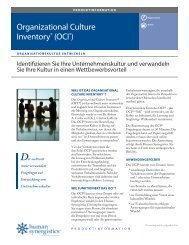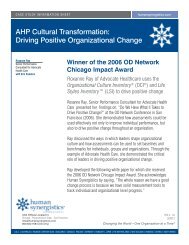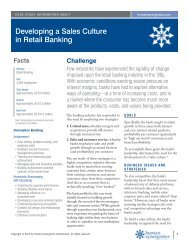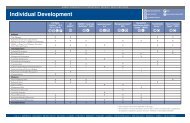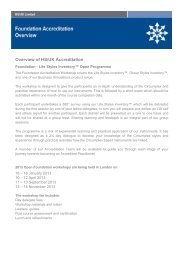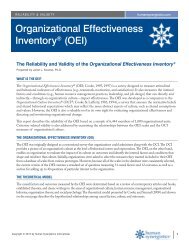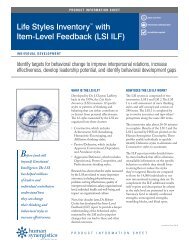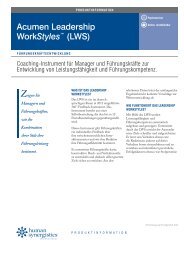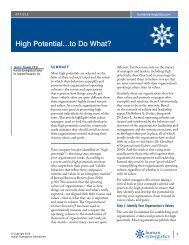A Cross-Cultural Perspective - Human Synergistics
A Cross-Cultural Perspective - Human Synergistics
A Cross-Cultural Perspective - Human Synergistics
Create successful ePaper yourself
Turn your PDF publications into a flip-book with our unique Google optimized e-Paper software.
CASE STUDY INFORMATION SHEET<br />
humansynergistics.com<br />
A <strong>Cross</strong>-<strong>Cultural</strong> <strong>Perspective</strong><br />
Facts<br />
Industry<br />
Telecommunications<br />
Region<br />
East Africa<br />
Background<br />
Since 1994, the client company, a<br />
government-owned telecommunications<br />
entity in East Africa, has been pursuing<br />
a Telecommunications Rehabilitation<br />
Program (TRP).<br />
In 1997 they engaged a UK consulting<br />
agency to prepare the organization for<br />
privatization.<br />
Leadership was identified as critical<br />
to the success of this process, so the<br />
strategy included development of key<br />
management.<br />
Challenges<br />
The first challenge that the facilitators<br />
faced involved how they planned<br />
to successfully implement <strong>Human</strong><br />
<strong>Synergistics</strong>’ methods and products in<br />
this environment. The group questioned<br />
whether applying a product of “Western<br />
capitalist” origin within a foreign culture<br />
(in a country that had only recently<br />
moved to democracy from a socialist<br />
socioeconomic model) would be relevant.<br />
Other challenges dealt directly with the<br />
composite of the company and their<br />
business position, such as:<br />
• The company embarked on a massive<br />
change process to become competitive<br />
in an increasingly globalized industry.<br />
This meant shifting a parochial, passive,<br />
and corrupt bureaucracy to a relatively<br />
high-performing, customer-focused<br />
business in just a few years.<br />
• A procession of foreign “experts”<br />
had left a legacy of wariness toward<br />
outsiders, and had undermined the<br />
collective self-esteem of the managers.<br />
• To maximize effectiveness, the<br />
facilitators wanted to avoid “selling” a<br />
solution. They instead needed to<br />
engage the participants in a learning<br />
approach that would equip them<br />
appropriately for the changes ahead.<br />
• Language barriers posed another<br />
challenge. Though high-level business<br />
is conducted in English, belowmanagement<br />
level’s primary language<br />
is Kiswahili, the common language<br />
across tribes.<br />
PROCESS<br />
The facilitators took two avenues to<br />
enable change within the company. One<br />
focused on leadership development<br />
and the other on strategies necessary<br />
in initiating their TRP. These strategies<br />
focused on improving:<br />
• Infrastructure—network now 90%<br />
digitized<br />
• Systems—technical, administrative<br />
and financial<br />
• HR strategies—a comprehensive<br />
customer care training program,<br />
reduction of work force from 8,000 to<br />
3,700 through redundancies and<br />
natural attrition<br />
Copyright © 2012 by <strong>Human</strong> <strong>Synergistics</strong> International. All rights reserved.<br />
1
CASE STUDY INFORMATION SHEET<br />
humansynergistics.com<br />
A <strong>Cross</strong>-<strong>Cultural</strong> <strong>Perspective</strong><br />
Figure 1: LSI 2 Profile: All<br />
Managers—1998<br />
Copyright © by <strong>Human</strong> <strong>Synergistics</strong> International. All rights reserved.<br />
Figure 2: LSI 2 Profile: Senior<br />
Managers—1998<br />
Copyright © by <strong>Human</strong> <strong>Synergistics</strong> International. All rights reserved.<br />
In order to assess the company’s<br />
leadership, the facilitators used the<br />
Life Styles Inventory (LSI) to set a<br />
benchmark goal, understand the current<br />
thinking styles within management,<br />
and look at positive change over time.<br />
Following are the leadership development<br />
strategies:<br />
Stage 1, June 1997, June 1998<br />
• Begin annual LSI 1 management<br />
development programs<br />
• Initiate individual coaching<br />
Stage 2, October 1998<br />
• LSI 2 program begins<br />
• Group Styles Inventory used for team<br />
building<br />
• Individual coaching and facilitated<br />
meetings with teams if requested by<br />
manager<br />
• Managers set three to four Key<br />
Performance Indicators (KPIs) relevant<br />
to their thinking style improvement<br />
goals to be tracked monthly<br />
Stage 3, April & October 1999<br />
• 2 x LSI 2 post-tests<br />
• Managers present their progress with<br />
KPIs<br />
Stage 4, April 2000<br />
• Leadership/Impact® assessment used for<br />
developing mid- to senior-level managers<br />
RESULTS<br />
ALL MANAGERS<br />
The facilitators began their efforts<br />
by compiling the October 1998 LSI<br />
2 profiles of all managers within the<br />
company. This composite profile shows an<br />
overall thinking style that is associated to<br />
the management as a whole (Figure 1).<br />
The high level of Passive/Defensive<br />
thinking and behavior reflect the:<br />
• government owned, socialist legacy<br />
• tribal background forming the typical<br />
operating system<br />
• bureaucracy<br />
• uncertain future for employees, with<br />
government plan to sell off a<br />
controlling share of the business<br />
• extremely high national<br />
unemployment (80% self-employed on<br />
the land)<br />
• down-sizing and redundancies<br />
that have resulted from the drive for<br />
efficiency<br />
Outwardly aggressive behavior is<br />
frowned upon in African culture and<br />
is not obvious in overt interactions;<br />
however, Aggressive/Defensive<br />
thinking is apparent in:<br />
• strict hierarchy, authoritative style,<br />
rigid reporting lines, and excessive<br />
formality (e.g., reference to people by<br />
title and position)<br />
• “big stick” approach used by managers<br />
to reduce endemic corruption<br />
• severe punishment of mistakes<br />
• unquestioning submission to those<br />
in higher authority (occurs naturally in<br />
tribal communities and seemingly has<br />
been transferred to the organizational<br />
context)<br />
SENIOR MANAGERS<br />
Figures 2 and 3 show the 1998 and<br />
1999 composite LSI 2 profiles for senior<br />
managers respectively.<br />
The 1998 results showed high levels of<br />
Passive and Aggressive/Defensive styles<br />
(all above the 75th percentile), and only the<br />
Constructive style of Self-Actualizing<br />
above the 50th percentile (Figure 2).<br />
2 Copyright © 2012 by <strong>Human</strong> <strong>Synergistics</strong> International. All rights reserved.
CASE STUDY INFORMATION SHEET<br />
humansynergistics.com<br />
A <strong>Cross</strong>-<strong>Cultural</strong> <strong>Perspective</strong><br />
Figure 3: LSI 2 Profile: Senior<br />
Managers—1999<br />
Copyright © by <strong>Human</strong> <strong>Synergistics</strong> International. All rights reserved.<br />
Figure 4: LSI Ideal Profile:<br />
1999<br />
Copyright © by <strong>Human</strong> <strong>Synergistics</strong> International. All rights reserved.<br />
The 1999 results show improvement in 11<br />
of the 12 styles. All of the Constructive<br />
styles increased to above the 50th<br />
percentile, while we see a decrease in 7<br />
of the 8 Defensive styles (Figure 3). This<br />
improved profile compared favorably to<br />
the 1998 All Managers LSI 2.<br />
PREFERRED STYLE<br />
In 1999, senior and middle management<br />
developed an LSI ideal, or preferred,<br />
profile during their training programs<br />
(Figure 4).<br />
While the current data suggests a typically<br />
poor management style, interactions with<br />
managers and their post-training activity<br />
demonstrates significant commitment to<br />
improving their effectiveness. Reports from<br />
many within the company indicate that<br />
managers are addressing both task and<br />
people aspects of their role as they work<br />
toward their preferred Constructive style.<br />
SUMMARY PERCEPTIONS<br />
In order to measure the correlation<br />
between thinking styles and perceived job<br />
effectiveness and quality of relationships,<br />
the facilitators questioned staff about<br />
their management. Workers were asked<br />
to rank their management’s effectiveness<br />
by answering, “How do you view this<br />
person’s level of effectiveness in his/<br />
her job?” for a number of leaders. The<br />
facilitators then compiled the LSI results<br />
of the 25% of leaders scoring highest in<br />
effectiveness and the 25% scoring lowest<br />
(Figure 5, on next page). The comparison<br />
of these two composite profiles shows a<br />
strong correlation between Constructive<br />
thinking styles and job effectiveness.<br />
To measure the quality of relationships in<br />
the workplace, the facilitators asked the<br />
work force, “How would you describe the<br />
quality of this person’s work relationships<br />
with others?” Here again, they compared<br />
the LSI profiles of the top-scoring 25%<br />
with those of the bottom-scoring 25%<br />
(Figure 6, on next page). We continue to<br />
see a correlation between positive work<br />
styles and constructive thinking, here in<br />
quality of relationships.<br />
OUTCOMES<br />
The impact of the project on the<br />
company performance was measurable:<br />
• Favorable performance trends have<br />
resulted in company-wide salary<br />
increases between 14% and 16.9%.<br />
• Over 90% of network faults are now<br />
repaired within 24 hours, and the total<br />
number of connections has increased.<br />
• Number of customer complaints is<br />
significantly reduced.<br />
Key learnings from the project include:<br />
• <strong>Cross</strong>-cultural validity<br />
• Numerous “Preferred” thinking<br />
circumplexes drawn by different<br />
groups show a desire for highly<br />
Constructive thinking styles, coupled<br />
with relatively low Defensive thinking<br />
Copyright © 2012 by <strong>Human</strong> <strong>Synergistics</strong> International. All rights reserved.<br />
3
CASE STUDY INFORMATION SHEET<br />
humansynergistics.com<br />
A <strong>Cross</strong>-<strong>Cultural</strong> <strong>Perspective</strong><br />
Figure 5: Job Effectiveness<br />
Top 25% Bottom 25%<br />
Copyright © by <strong>Human</strong> <strong>Synergistics</strong> International. All rights reserved.<br />
Figure 6: Quality of Relationship<br />
Top 25% Bottom 25%<br />
Copyright © by <strong>Human</strong> <strong>Synergistics</strong> International. All rights reserved.<br />
4 Copyright © 2012 by <strong>Human</strong> <strong>Synergistics</strong> International. All rights reserved.
CASE STUDY INFORMATION SHEET<br />
humansynergistics.com<br />
A <strong>Cross</strong>-<strong>Cultural</strong> <strong>Perspective</strong><br />
About the Circumplex<br />
<strong>Human</strong> <strong>Synergistics</strong> International’s Circumplex provides a way to “see” what drives the performance of individual contributors, leaders, work teams and,<br />
in short, the entire organization. It illustrates the factors underlying performance in terms of 12 styles of thinking and behaving. Some styles lead to<br />
effectiveness and productivity; some do not. Regardless of their impact, they all describe what’s happening inside the organization and provide a direction<br />
for change and development.<br />
11<br />
Members are expected to set<br />
challenging but realistic goals and<br />
solve problems effectively<br />
Effective individuals in groups and<br />
organizations show STRONGER<br />
tendencies along the Constructive styles.<br />
12<br />
Members are expected to gain<br />
enjoyment from their work and<br />
produce high-quality<br />
products/services<br />
1<br />
Members are expected to be<br />
supportive, constructive, and<br />
open to influence in their dealings<br />
with each other<br />
9<br />
10<br />
Members are expected<br />
to avoid making mistakes, work<br />
long hours, and keep “on top” of<br />
everything<br />
Members are expected<br />
to operate in a “win-lose”<br />
framework and work against<br />
their peers to be noticed<br />
8<br />
Members are expected<br />
to take charge and “control” others,<br />
and make decisions autocratically<br />
2<br />
Members are expected to be<br />
friendly, open, and sensitive to the<br />
satisfaction of the work group<br />
3<br />
Members are expected<br />
to agree with, gain the approval<br />
of, and be liked by others<br />
4<br />
Members are expected<br />
to conform, follow the rules, and<br />
make a good impression<br />
Effective individuals in groups<br />
and organizations show<br />
WEAKER tendencies along the<br />
Aggressive/Defensive styles.<br />
7<br />
Members are expected<br />
to gain status and influence by<br />
being critical and constantly<br />
challenging one another<br />
6<br />
Members are expected<br />
to shift responsibilities to others<br />
and avoid being blamed for<br />
mistakes<br />
5<br />
Members are expected<br />
to do what they are told and clear<br />
all decisions with superiors<br />
Research & Development by:<br />
Robert A. Cooke, Ph.D.<br />
J. Clayton Lafferty, Ph.D.<br />
Copyright © 1973-2009<br />
by <strong>Human</strong> <strong>Synergistics</strong> International.<br />
All rights reserved.<br />
Effective individuals in groups<br />
and organizations show<br />
WEAKER tendencies along the<br />
Passive/Defensive styles.<br />
Research & Development by Robert A. Cooke, Ph.D., and J. Clayton Lafferty, Ph.D. Copyright © by <strong>Human</strong> <strong>Synergistics</strong> International. All Rights Reserved.<br />
U.S.A. AUSTRALIA BELGIUM BRITISH ISLES BULGARIA CANADA FINLAND GERMANY HUNGARY JAPAN THE NETHERLANDS NEW ZEALAND ROMANIA SERBIA SOUTH KOREA<br />
humansynergistics.com<br />
Creators of the Organizational Culture Inventory ® , Desert Survival Situation,<br />
Life Styles Inventory and Leadership/Impact ® .<br />
HSI v. 2.0<br />
7/2012<br />
5<br />
Changing the World—<br />
One Organization at a Time ®<br />
Copyright © 2012 by <strong>Human</strong> <strong>Synergistics</strong> International. No part of this work may be reproduced, translated, stored in a retrieval system,<br />
transcribed in any form or by any means, including, but not limited to electronic, mechanical, photocopying, recording or other means,<br />
without prior written permission of <strong>Human</strong> <strong>Synergistics</strong> International. Please direct correspondence to <strong>Human</strong> <strong>Synergistics</strong> International<br />
at 39819 Plymouth Road, Plymouth, MI 48170 U.S.A., (1.734.459.1030). While we’re not vengeful, we are provokable ® .



